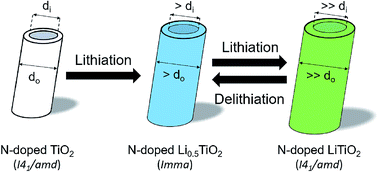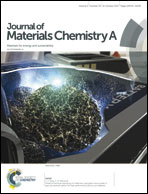In situ TEM observation of the electrochemical lithiation of N-doped anatase TiO2 nanotubes as anodes for lithium-ion batteries†
Abstract
Due to their high specific capacity and negligible volume expansion during cycling, anatase titanium dioxide (a-TiO2) nanotubes have been considered as a prime candidate for anodes in lithium-ion batteries. However, their rate capability for electrochemical cycling is limited by the low electronic conductivity of a-TiO2 nanotubes. Here, we show that a desirable amount of nitrogen doping can significantly enhance the electronic conductivity in a-TiO2 nanotubes, resulting in improvements in both the capacity stability and the rate capability at fast charge–discharge rates. Electron energy loss spectroscopy revealed a high doping concentration of nitrogen (∼5%) by substituting for oxygen ions in a-TiO2 nanotubes. The lithiation mechanism of N-doped a-TiO2 nanotubes was further investigated using in situ transmission electron microscopy, where a three-step lithiation mechanism was revealed. Lithium ions initially intercalate into the a-TiO2 lattice structure. Further insertion of lithium ions triggers a phase transformation from a-TiO2 to orthorhombic Li0.5TiO2 and finally to polycrystalline tetragonal LiTiO2. Our results reveal that nitrogen doping significantly facilitates lithiation in TiO2 through enhanced electronic conductivity, while the structural and chemical evolutions during the lithiation process remain similar to those of undoped TiO2.



 Please wait while we load your content...
Please wait while we load your content...